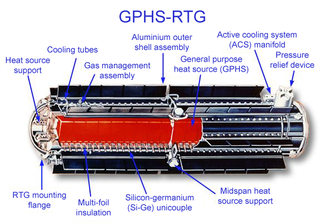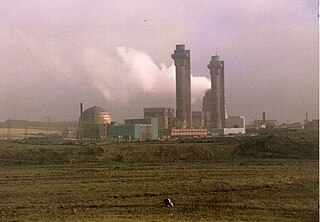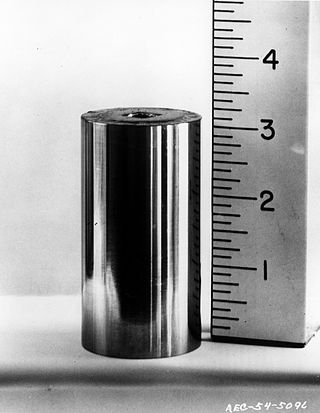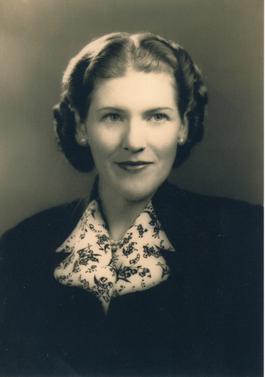
The pebble-bed reactor (PBR) is a design for a graphite-moderated, gas-cooled nuclear reactor. It is a type of very-high-temperature reactor (VHTR), one of the six classes of nuclear reactors in the Generation IV initiative.

A radioisotope thermoelectric generator, sometimes referred to as a radioisotope power system (RPS), is a type of nuclear battery that uses an array of thermocouples to convert the heat released by the decay of a suitable radioactive material into electricity by the Seebeck effect. This type of generator has no moving parts.

Sellafield is a large multi-function nuclear site close to Seascale on the coast of Cumbria, England. As of August 2022, primary activities are nuclear waste processing and storage and nuclear decommissioning. Former activities included nuclear power generation from 1956 to 2003, and nuclear fuel reprocessing from 1952 to 2022. Reprocessing ceased on 17 July 2022, when the Magnox Reprocessing Plant completed its last batch of fuel after 58 years of operation.

The Atomic Energy Research Establishment (AERE) was the main centre for atomic energy research and development in the United Kingdom from 1946 to the 1990s. It was created, owned and funded by the British Government.

A nuclear and radiation accident is defined by the International Atomic Energy Agency (IAEA) as "an event that has led to significant consequences to people, the environment or the facility. Examples include lethal effects to individuals, large radioactivity release to the environment, reactor core melt." The prime example of a "major nuclear accident" is one in which a reactor core is damaged and significant amounts of radioactive isotopes are released, such as in the Chernobyl disaster in 1986 and Fukushima nuclear disaster in 2011.

The United Kingdom Atomic Energy Authority is a UK government research organisation responsible for the development of fusion energy. It is an executive non-departmental public body of the Department for Business, Energy and Industrial Strategy (BEIS).

Radioactive contamination, also called radiological pollution, is the deposition of, or presence of radioactive substances on surfaces or within solids, liquids, or gases, where their presence is unintended or undesirable.

Dounreay is a small settlement and the site of two large nuclear establishments on the north coast of Caithness in the Highland area of Scotland. It is on the A836 road nine miles west of Thurso.
Biotechnology and Biological Sciences Research Council (BBSRC), part of UK Research and Innovation, is a non-departmental public body (NDPB), and is the largest UK public funder of non-medical bioscience. It predominantly funds scientific research institutes and university research departments in the UK.
Long Ashton Research Station (LARS) was an agricultural and horticultural government-funded research centre located in the village of Long Ashton near Bristol, UK. It was created in 1903 to study and improve the West Country cider industry and became part of the University of Bristol in 1912. Later, it expanded into fruit research and in the 1980s was redirected to work on arable crops and aspects of botany. It closed in 2003. The Research Station is commonly known for developing Ribena a still popular vitamin C-rich drink that was widely distributed in the UK during the Second World War, and the Long Ashton Nutrient Solution (LANS).

The Windscale fire of 10 October 1957 was the worst nuclear accident in the United Kingdom's history, and one of the worst in the world, ranked in severity at level 5 out of a possible 7 on the International Nuclear Event Scale. The fire was in Unit 1 of the two-pile Windscale site on the north-west coast of England in Cumberland. The two graphite-moderated reactors, referred to at the time as "piles," had been built as part of the British post-war atomic bomb project. Windscale Pile No. 1 was operational in October 1950, followed by Pile No. 2 in June 1951.

Caesium-137, cesium-137 (US), or radiocaesium, is a radioactive isotope of caesium that is formed as one of the more common fission products by the nuclear fission of uranium-235 and other fissionable isotopes in nuclear reactors and nuclear weapons. Trace quantities also originate from spontaneous fission of uranium-238. It is among the most problematic of the short-to-medium-lifetime fission products. Caesium-137 has a relatively low boiling point of 671 °C (1,240 °F) and is volatilized easily when released suddenly at high temperature, as in the case of the Chernobyl nuclear accident and with atomic explosions, and can travel very long distances in the air. After being deposited onto the soil as radioactive fallout, it moves and spreads easily in the environment because of the high water solubility of caesium's most common chemical compounds, which are salts. Caesium-137 was discovered by Glenn T. Seaborg and Margaret Melhase.
The Centre for Environment, Fisheries and Aquaculture Science (Cefas) is an executive agency of the United Kingdom government Department for Environment, Food and Rural Affairs (Defra). It carries out a wide range of research, advisory, consultancy, monitoring and training activities for a large number of customers around the world.

Lorna Margaret Arnold was a British historian who wrote a number of books connected with the British nuclear weapons programmes.

The Kyshtym disaster, sometimes referred to as the Mayak disaster or Ozyorsk disaster in newer sources, was a radioactive contamination accident that occurred on 29 September 1957 at Mayak, a plutonium production site for nuclear weapons and nuclear fuel reprocessing plant located in the closed city of Chelyabinsk-40 in Chelyabinsk Oblast, Russian SFSR, Soviet Union.
Project GABRIEL was an investigation to gauge the impact of nuclear fallout resulting from nuclear warfare. The United States Atomic Energy Commission surmised that the radioactive isotope strontium-90 (Sr-90) presented the greatest hazard to life globally, which resulted in the commissioning of Project SUNSHINE: which sought to examine the levels of Sr-90 in human tissues and bones gathered from around the world.

Bioremediation of radioactive waste or bioremediation of radionuclides is an application of bioremediation based on the use of biological agents bacteria, plants and fungi to catalyze chemical reactions that allow the decontamination of sites affected by radionuclides. These radioactive particles are by-products generated as a result of activities related to nuclear energy and constitute a pollution and a radiotoxicity problem due to its unstable nature of ionizing radiation emissions.

The Windscale Piles were two air-cooled graphite-moderated nuclear reactors on the Windscale nuclear site in Cumberland on the north-west coast of England. The two reactors, referred to at the time as "piles", were built as part of the British post-war atomic bomb project and produced weapons-grade plutonium for use in nuclear weapons.

Sir William Leonard Owen was a British civil engineer and nuclear engineer. As Director of Engineering at the British Atomic Energy Project, he oversaw the construction of the Springfields Chemical and Fuel Element Plants, the Windscale Piles, Windscale plutonium extraction plant, Capenhurst gaseous diffusion plant and the Calder Hall nuclear power station.
The Chernobyl disaster remains the major and most detrimental nuclear catastrophe which completely altered the radioactive background of the Northern Hemisphere. It happened in April 1986 on the territory of the former Soviet Union. The catastrophe led to the increase of radiation in nearly one million times in some parts of Europe and North America compared to the pre-disaster state Air, water, soils, vegetation and animals were contaminated to a varying degree. Apart from Ukraine and Belarus as the worst hit areas, adversely affected countries included Russia, Austria, Finland and Sweden. The full impact on the aquatic systems, including primarily adjacent valleys of Pripyat river and Dnieper river, are still unexplored.
















